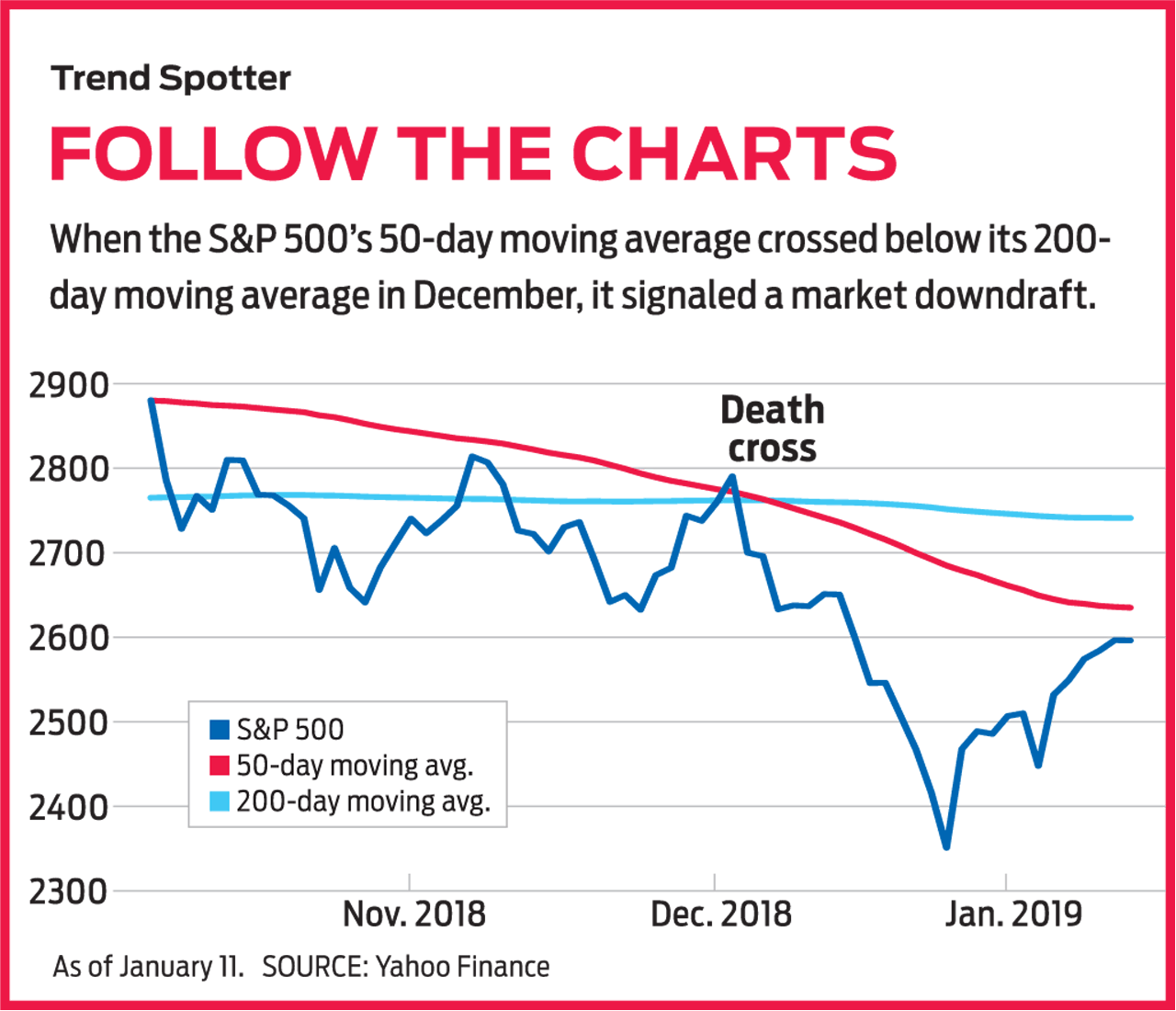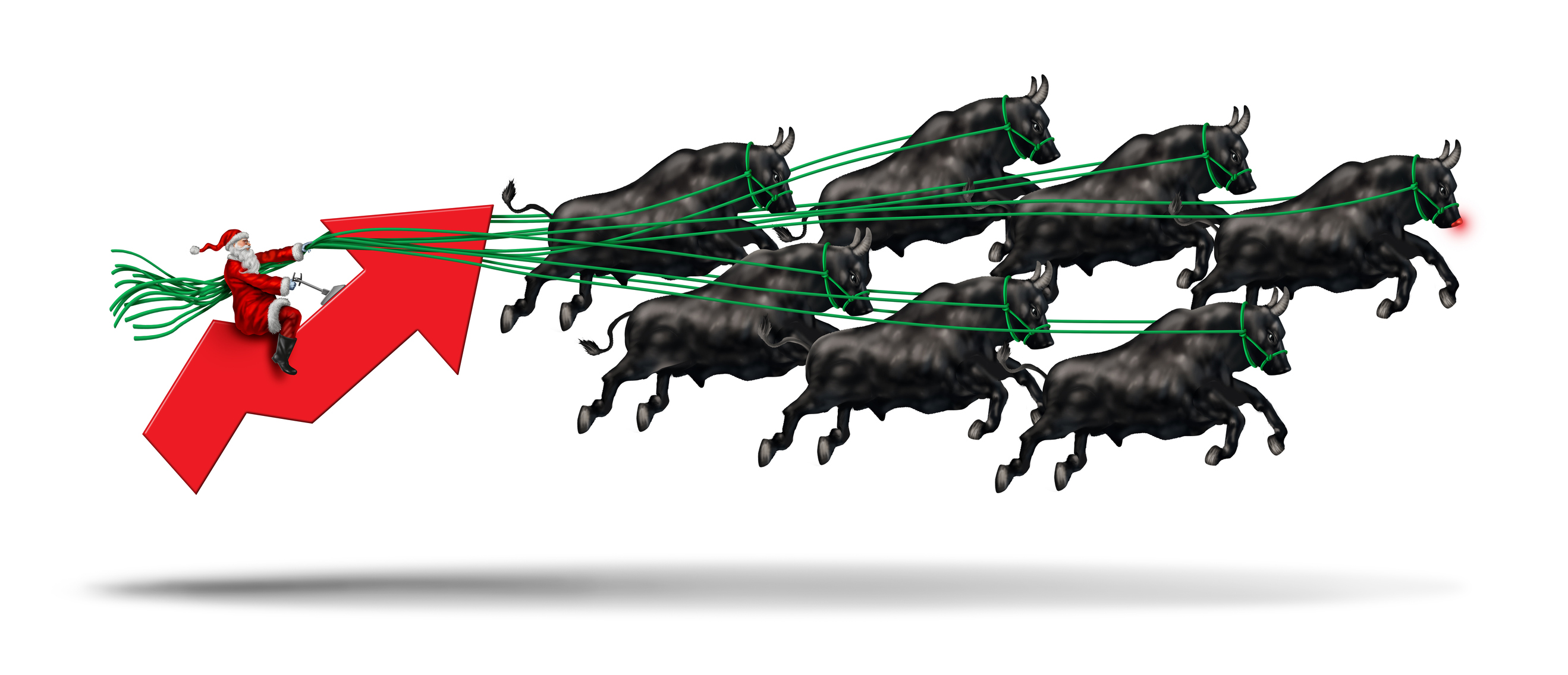The Magic of Moving Averages
This technical indicator can help predict where stocks are headed.

When price charts begin to look like jagged mountain ranges, it can be hard to map out which way stocks are headed. Enter the simple moving average. The tool is a staple of technical analysis—the practice of determining the direction of stock prices based on statistical patterns. It can sharpen the stock market picture, and, although a moving average won’t pinpoint peaks or troughs, it can tell you whether the momentum of a stock or an index is up or down.
A simple moving average is calculated by adding up a stock’s or an index’s daily closing prices over a given period—the most popular periods are 50 days and 200 days—and dividing by the number of days in that period. A moving average “effectively smooths out the noise of daily price swings, so that investors can see which way things are trending,” says William Delwiche, an investment analyst at financial services firm Baird. Moving averages can be superimposed on stock charts on nearly any brokerage website, as well as on free sites, such as Yahoo Finance.
Stock prices that diverge from the prevailing trend of a moving average can be a signal to buy or sell—or at least to become more bullish or bearish. When a stock’s price falls below its moving average, it’s considered a sign of a weakening trend and indicates heightened risk and uncertainty, says Mark Dodson, research director at investment management firm Cypress Capital. “Adopting a simple rule, such as not buying a stock until its price rises above its 50- or 200-day moving average, can help you avoid riding a company to the bottom,” he says.
From just $107.88 $24.99 for Kiplinger Personal Finance
Become a smarter, better informed investor. Subscribe from just $107.88 $24.99, plus get up to 4 Special Issues

Sign up for Kiplinger’s Free Newsletters
Profit and prosper with the best of expert advice on investing, taxes, retirement, personal finance and more - straight to your e-mail.
Profit and prosper with the best of expert advice - straight to your e-mail.

When a price rises above the moving average, investors should be more risk-tolerant and aggressive, Dodson adds. For example, Facebook’s 50-day moving average may be signaling better days ahead for the beleaguered social media stock. The stock has surrendered 18% since falling below its 50-day moving average last July, but it began trading above its average in early January. (Returns and other data in this story are through January 11.)
Crossed signals. More-advanced technical analysis focuses on the interaction between longer- and shorter-term moving averages. During a healthy bull market, for example, both the 50-day moving average and the 200-day moving average would be headed in the same direction, with the 50-day average higher than the 200-day indicator.
But when a 50-day moving average dips below an investment’s 200-day average, it results in a scary-sounding red flag: the “death cross.” That’s what happened with Standard & Poor’s 500-stock index in early December. The death cross is a “definite sell signal,” says Louise Yamada, author of the newsletter TechPoints, as it indicates that a short-term pullback may be devolving into a long-term downturn. The inverse, the “golden cross,” is considered a buy signal.
But the death cross is far from being a perfect indicator of prolonged market slides. Although the S&P 500 came perilously close to a bear market in late December, it has since turned around, so it remains to be seen whether the most recent instance was prescient or a false alarm. Though a cross in December 2007 presaged the worst of the ’07–’09 bear market, crosses in 2011 and 2015 signaled market slides that never became full-fledged bears.
For fundamentals-based investors—those who rely on data such as corporate earnings and economic growth—poring over stock charts can seem like reading tea leaves. But technical signals can be a valuable tool to get a sense of the market’s underlying trends, as long as investors understand that they’re only part of a larger toolbox, says Delwiche. “Don’t try to turn these signals into foolproof market-timing devices,” he says.
Profit and prosper with the best of Kiplinger's advice on investing, taxes, retirement, personal finance and much more. Delivered daily. Enter your email in the box and click Sign Me Up.

Ryan joined Kiplinger in the fall of 2013. He wrote and fact-checked stories that appeared in Kiplinger's Personal Finance magazine and on Kiplinger.com. He previously interned for the CBS Evening News investigative team and worked as a copy editor and features columnist at the GW Hatchet. He holds a BA in English and creative writing from George Washington University.
-
 The Wealth Equation: Balancing Money and Stress
The Wealth Equation: Balancing Money and StressSponsored Don’t let assets be a liability that strains your family.
-
 Is Your Emergency Fund Running Low? Here's How to Bulk It Up
Is Your Emergency Fund Running Low? Here's How to Bulk It UpIf you're struggling right now, you're not alone. Here's how you can identify financial issues, implement a budget and prioritize rebuilding your emergency fund.
-
 Guide to How All-Assets Planning Offers a Better Retirement
Guide to How All-Assets Planning Offers a Better RetirementAn "all-asset" strategy would integrate housing wealth and annuities with traditional investments to generate more income and liquid savings for retirees.
-
 Stocks Struggle for Gains to Start 2026: Stock Market Today
Stocks Struggle for Gains to Start 2026: Stock Market TodayIt's not quite the end of the world as we know it, but Warren Buffett is no longer the CEO of Berkshire Hathaway.
-
 If You'd Put $1,000 Into Lowe's Stock 20 Years Ago, Here's What You'd Have Today
If You'd Put $1,000 Into Lowe's Stock 20 Years Ago, Here's What You'd Have TodayLowe's stock has delivered disappointing returns recently, but it's been a great holding for truly patient investors.
-
 Stocks End Volatile Year on a Down Note: Stock Market Today
Stocks End Volatile Year on a Down Note: Stock Market TodayAfter nearing bear-market territory in the spring, the main market indexes closed out the year with impressive gains.
-
 Stocks Extend Losing Streak After Fed Minutes: Stock Market Today
Stocks Extend Losing Streak After Fed Minutes: Stock Market TodayThe Santa Claus Rally is officially at risk after the S&P 500's third straight loss.
-
 If You'd Put $1,000 Into 3M Stock 20 Years Ago, Here's What You'd Have Today
If You'd Put $1,000 Into 3M Stock 20 Years Ago, Here's What You'd Have TodayMMM stock has been a pit of despair for truly long-term shareholders.
-
 Santa Claus Rally at Risk as Tech Stocks Slump: Stock Market Today
Santa Claus Rally at Risk as Tech Stocks Slump: Stock Market TodayThe Nasdaq Composite and Dow Jones Industrial Average led today's declines as investors took profits on high-flying tech stocks.
-
 Gold and Silver Shine as Stocks Chop: Stock Market Today
Gold and Silver Shine as Stocks Chop: Stock Market TodayStocks struggled in Friday's low-volume session, but the losses weren't enough to put the Santa Claus Rally at risk.
-
 The Santa Claus Rally Officially Begins: Stock Market Today
The Santa Claus Rally Officially Begins: Stock Market TodayThe Santa Claus Rally is officially on as of Wednesday's closing bell, and initial returns are positive.